[front cover]
NO. I. OF PART II.]
[PRICE 10s.
THE
ZOOLOGY
OF
THE VOYAGE OF H.M.S. BEAGLE,
UNDER THE COMMAND OF CAPTAIN FITZROY,
DURING THE YEARS
1832 TO 1836.
————
PUBLISHED WITH THE APPROVAL OF
THE LORDS
COMMISSIONERS OF HER MAJESTY'S TREASURY.
————
Edited and Superintended by
CHARLES DARWIN, ESQ. M.A. F.G.S.
CORRESPONDING MEMBER OF THE ZOOLOGICAL SOCIETY,
AND NATURALIST TO THE EXPEDITION.
————————————————————————————————
MAMMALIA,
BY GEORGE R. WATERHOUSE, ESQ.
CURATOR OF THE ZOOLOGICAL SOCIETY OF LONDON, ETC. ETC.
————————————
LONDON :
SMITH, ELDER AND CO., 65, CORNHILL.
MDCCCXXXVIII.
STEWART AND MURRAY, OLD BAILEY.
[inside front cover]
[page break]
[page break]
[title page]
MAMMALIA,
Described by
GEORGE R. WATERHOUSE, ESQ.
CURATOR OF THE ZOOLOGICAL SOCIETY OF LONDON, ETC. ETC.
WITH
A NOTICE OF THEIR HABITS AND RANGES,
BY CHARLES DARWIN, ESQ. M.A. F.G.S. &c.
CORRESPONDING MEMBER OF THE ZOOLOGICAL SOCIETY.
[page break]
[page i]
GEOGRAPHICAL INTRODUCTION.
BY MR. DARWIN.
~~~~~~~~~~~~~~~~
THE object of the present Introduction, is briefly to describe the principal localities, from which the Zoological specimens, collected during the voyage of the Beagle, were obtained. At the conclusion of this work, after each species has been separately examined and described, it will be more advantageous to incorporate any general remarks. The Beagle was employed for nearly five years out of England; of this time a very large proportion was spent in surveying the coasts of the Southern part of South America, and of the remainder, much was consumed in making long passages during her circumnavigation of the globe. Hence nearly the entire collection, especially of the animals belonging to the higher orders, was procured from this continent; to which, however, must be added the Galapagos Archipelago, a group of islands in the Pacific, but not far distant from the American coast. The localities may be briefly described under the following heads.
BRAZIL. This country presents an enormous area, supporting the most luxuriant productions of the intertropical regions. It is composed of primary formations, and may be considered as being hilly rather than mountainous. LA PLATA includes the several provinces bordering that great river; — namely, Buenos Ayres, Banda Oriental, Santa Fé, Entre Rios, &c. My collections were chiefly made at BUENOS AYRES, at MONTE VIDEO, the capital of Banda Oriental, and at MALDONADO, a town in the same province, situated on the northern
a
[page] ii ZOOLOGY OF THE VOYAGE OF THE BEAGLE.
shore, near the mouth of the estuary of the Plata. These countries consist either of an undulating surface, clothed with turf, or of perfectly level plains with enormous beds of thistles. Except on the banks of the rivers, trees nowhere grow; there are, however, thickets in some of the valleys, in the more hilly parts of Banda Oriental. During the winter and spring of this hemisphere, a considerable quantity of rain falls, and the plains of turf are then everywhere verdant; but in summer the country assumes a brown and parched appearance.
BAHIA BLANCA forms a large bay, in latitude 39° S. on a part of the coast, which falls within the territory of the province of Buenos Ayres, but which from its physical conditions would more properly be classed with Patagonia. The tertiary plains of PATAGONIA, extend from the Strait of Magellan to the Rio Negro, which is commonly assumed as their Northern boundary. This space of more than seven hundred miles in length, and in breadth reaching from the Cordillera to the Atlantic Ocean, is everywhere characterised by the dreary uniformity of its landscape. Nearly desert plains, composed of a thick bed of shingle, and often strewed over with sea-shells, (plainly indicating that the land has been covered within a recent period by the sea,) are but rarely interrupted by hills of porphyry, and other crystalline rocks. The plains support scattered tufts of wiry grass, and stunted bushes; whilst in the broad flat-bottomed valleys, dwarf thorn-bearing trees, barely ornamented with the scantiest foliage, sometimes unite into thickets; and here the few feathered inhabitants of these sterile regions resort. There is an extreme scarcity of water; and where it is found, especially if in lakes, it is generally as salt as brine. The sky in summer is cloudless, and the heat in consequence, considerable; whereas the frosts of winter are, sometimes, severe. The principal localities visited by the Beagle, were the RIO NEGRO, in latitude 41° S., PORT DESIRE, PORT ST. JULIAN, and SANTA CRUZ. At the latter place, a party, under the command of Captain FitzRoy, followed up the river in boats, to within a few miles of the Cordillera; and an opportunity was thus afforded of verifying the nature of the country in its entire breadth. At the Rio Negro the plains are much more thickly covered with bushes, (chiefly acacias,) than in any other part of Patagonia.
TIERRA DEL FUEGO may be supposed to include all the broken land south of a line joining the opposite mouths of the Strait of Magellan. The land is moun-
[page] iii GEOGRAPHICAL INTRODUCTION.
tainous, and may be aptly compared to a lofty chain, partly submerged in the sea; —bays and channels occupying the position of valleys. The Eastern side almost exclusively consists of clay-slate; the Western, of primary, and various plutonic formations. The mountains, from the water's edge, to within a short distance of the lower limit of perpetual snow, are everywhere (excepting on the exposed western shores) concealed by an impervious forest, the trees of which do not periodically shed their leaves. On the East coast, the outline of the land shows that tertiary formations, like those of Patagonia, extend south of the Strait of Magellan; but with the exception of this part, it is rare to find even a small space of level ground; and where such occurs, a thick bed of peat invariably covers the surface. The climate is of that kind which has been denominated insular: the winters are far from being excessively cold, whilst the summers are gloomy, boisterous, and seldom cheered by the rays of the sun. In all seasons, a large quantity of rain falls. Hence, from the physical conditions of Tierra del Fuego, all the land animals must live either on the sea beach, (and in this class the Aborigines may be included) or within the humid and entangled forests.
The FALKLAND ISLANDS are situated in the same latitude as the Eastern entrance of the Strait of Magellan, and about 270 miles East of it. The climate is nearly the same as in Tierra del Fuego, but the surface of the land, instead of being as there, concealed by one great forest, does not support a single tree. We see on every side a withered and coarse herbage, with a few low bushes, which spring from the peaty soil of an undulating moorland. Scattered hills, and a central range of quartz rock, protrude through formations of clay-slate and sand-stone (belonging to the Silurian epoch,) which compose the lower country.
The structure of the west coast of South America, from the Strait of Magellan northward to latitude 38°, in its greater part, (as far north as Chiloe) is very similar to that of Tierra del Fuego. The climate likewise is similar,—being gloomy, boisterous, and extremely humid; and, consequently, the land is concealed by an almost impenetrable forest. In the northern part of this region, the temperature of course is considerably higher than near the Strait of Magellan; but nevertheless it is much less so, than might have been anticipated from so
a 2
[page] iv ZOOLOGY OF THE VOYAGE OF THE BEAGLE.
great a change in latitude. Hence, although the vegetation of this northern district presents a marked difference when compared with that of the southern; yet the zoology in many respects has, like the general aspect of the landscape, a very uniform character. The specimens were chiefly collected from the PENINSULA OF TRES MONTES, the CHONOS ARCHIPELAGO (from latitude 46° to 43° 30'), CHILOE with the adjoining islets, and VALDIVIA. The contrast between the physical conditions and productions of the East and West coasts of this part of South America is very remarkable. On one side of the Cordillera, great heavy clouds are driven along by the western gales in unbroken sheets, and the indented land is clothed with thick forests; whilst on the other side of this great range, a bright sky, with a clear and dry atmosphere, extends over wide and desolate plains.
CHILE in the neighbourhood of CONCEPCION (latitude 36° 42' S.) may be called a fertile land; for it is diversified with fine woods, pasturage, and cultivated fields. But towards the more central districts (near VALPARAISO and SANTIAGO) although by the aid of irrigation, the soil in the valleys yields a most abundant return, yet the appearance of the hills, thinly scattered with various kinds of bushes and cylindrical Opuntias, bespeaks an arid climate. In winter, rain is copious, but during a long summer of from six to eight months, a shower never moistens the parched soil. The country has a very alpine character, and is traversed by several chains of mountains extending parallel to the Andes. These ranges include between them level basins, which appear once to have formed the beds of ancient channels and bays, such as those now intersecting the land further to the south. North of the neighbourhood of Valparaiso, the climate rapidly becomes more and more arid, and the land in proportion desert. Beyond the valley of COQUIMBO (latitude 30°.) it is scarcely habitable, excepting in the valleys of Guasco, Copiapó, and Paposa, which owe their entire fertility to the system of irrigation, invented by the aboriginal Indians and followed by the Spanish colonists. Northward of these places, the absolute desert of Atacama forms a complete barrier, and eastward, the snow-clad chain of the Cordillera separates the Zoological province of Chile, from that of the wide plains which extend on the other side of the Andes.
The last district which it is at all necessary for me to mention here, is that
[page] v GEOGRAPHICAL INTRODUCTION.
of the GALAPAGOS ARCHIPELAGO, situated under the Equator, and between five and six hundred miles West of the coast of America. These islands are entirely volcanic in their composition; and on two of them the volcanic forces have within late years been seen in activity. There are five principal islands, and several smaller ones: they cover a space of 2° 10' in latitude, and 2° 35' in longitude. The climate, for an equatorial region, is far from being excessively hot: it is extremely dry; and although the sky is often clouded, rain seldom falls, excepting during one short season, and then its quantity is variable. Hence, in the lower part of these islands, even the more ancient streams of lava (the recent ones still remaining naked and glossy) are clothed only with thin and nearly leafless bushes. At an elevation of 1200 feet, and upwards, the land receives the moisture condensed from the clouds, which are drifted by the trade wind over this part of the ocean at an inconsiderable height. In consequence of this, the upper and central part of each island supports a green and thriving vegetation; but from some cause, not very easily explained, it is much less frequented, than the lower and rocky districts are, by the feathered inhabitants of this archipelago.
By a reference to the localities here described, it is hoped that the reader will obtain some general idea of the nature of the different countries inhabited by the several animals, which will be described in the following sheets.
The vertebrate animals in my collection have been presented to the following museums: — the Mammalia and Birds to the Zoological Society; the Fishes to the Cambridge Philosophical Society; and the Reptiles, when described, will be deposited in the British Museum. For the care and preservation of all these and other specimens, during the long interval of time between their arrival in this country and my return, I am deeply indebted to the kindness of the Rev. Professor Henslow of Cambridge. With respect to the gentlemen, who have undertaken the several departments of this publication, I hope they will permit me here to express the great personal obligation which I feel towards them, and likewise my admiration at the disinterested zeal which has induced them thus to bestow their time and talents for the good of Science.
[page vi]
[page 1]
MAMMALIA.
~~~~~~~~~~~~~~~~
FAMILY—PHYLLOSTOMIDÆ.
DESMODUS D'ORBIGNYI.
PLATE I. Natural size. Skull, teeth, &c. Pl. XXXV., figs. 1.
D. pilis nitidis adpressis; corpore suprà fusco, pilis ad basin albis; gulâ abdomineque cinerescenti-albis; nasûs prosthemate parvulo bifido.
DESCRIPTION.—The fur of this Bat is glossy and has a silk-like appearance; that on the top of the head, sides of the face, and the whole of the upper parts of the body, is of a deep brown colour; all the hairs on these parts, however, are white at the base. The flanks, interfemoral membrane, and the arms, are also covered on their upper side with brown hairs. On the lower part of the sides of the face, and the whole of the under parts of the body, the hairs are of an ashy-white colour. The membrane of the wing is brownish. The ears are of moderate size, and somewhat pointed; externally they are covered with minute brown hairs, and internally with white. The tragus is also covered with white hairs; it is of a narrow form, pointed at the tip, and has a small acute process in the middle of the outer margin. The nose-leaf is pierced by the nostrils, which diverge posteriorly, and is so deeply cleft on its hinder margin, that it may be compared to two small leaflets joined side by side near their bases. These leaflets, unlike the nose-leaf of the Phyllostomina, lie horizontally on the nose to which they are attached throughout, a slight ridge only indicating their margin. Around the posterior part of the nose-leaf there is a considerable naked space, in which two small hollows are observable, situated one on each side, and close to the
B
[page] 2 ZOOLOGY OF THE VOYAGE OF THE BEAGLE.
nose-leaf; and, at a short distance behind the nose-leaf, this naked membrane is slightly elevated, and forms a transverse fleshy tubercle.
In. |
Lines. |
In. |
Lines. |
||||
Length of |
head and body . . . |
3 |
3 |
Length of |
tarsus (claw included) . . |
0 |
81/3 |
interfemoral membrane . . |
0 |
3½ |
ear . . . . . |
0 |
4 |
||
the antibrachium . . . |
2 |
2 |
tragus . . . . . |
0 |
3 |
||
thumb (claw included) . . |
0 |
8 |
nose-leaf . . . . |
0 |
2¼ |
||
tibia . . . . . |
0 |
10 |
Expanse of |
the wings . . . . |
12 |
8 |
Habitat, Coquimbo, Chile. (May.)
"The Vampire Bat," says Mr. Darwin in his MS. notes upon the present species, "is often the cause of much trouble, by biting the horses on their withers. The injury is generally not so much owing to the loss of blood, as to the inflammation which the pressure of the saddle afterwards produces. The whole circumstance has lately been doubted in England; I was therefore fortunate in being present when one was actually caught on a horse's back. We were bivouacking late one evening near Coquimbo, in Chile, when my servant, noticing that one of the horses was very restive, went to see what was the matter, and fancying he could distinguish something, suddenly put his hand on the beast's withers, and secured the Vampire. In the morning, the spot where the bite had been inflicted was easily distinguished from being slightly swollen and bloody. The third day afterwards we rode the horse, without any ill effects.
Before the introduction of the domesticated quadrupeds, this Vampire Bat probably preyed on the guanaco, or vicugna, for these, together with the puma, and man, were the only terrestrial mammalia of large size, which formerly inhabited the northern part of Chile. This species must be unknown, or very uncommon in Central Chile, since Molina, who lived in that part, says (Compendio de la Historia del Reyno de Chile, vol. i. p. 301,) "that no blood-sucking species is found in this province."
It is interesting to find that the structure of this animal is in perfect accordance with the habits as above detailed by Mr. Darwin. Among other points, the total absence of true molars, and consequent want of the power of masticating food, is the most remarkable. On the other hand we find the canines and incisors perfectly fitted for inflicting a wound such as described, while the small size of the interfemoral membrane (giving freedom to the motions of the legs,) together with the unusually large size of the thumb and claw, would enable this Bat, as I should imagine, to fix itself with great security to the body of the horse.
I have named this species after M. d'Orbigny, who has added so much to
[page] 3 MAMMALIA.
our information on the zoological productions of South America. The Edostoma cinerea* of that author has evidently a close affinity to the animal here described, and differs chiefly (judging from the drawing published in his work) in the larger size of the ears, in having the nose-leaf free, and the surrounding membrane free and elevated.
As M. d'Orbigny has not yet published the character of his genus Edostoma, his figure is my only guide, and in this figure I find the dentition agreeing both with that of the present species, and that of the genus Desmodus of Prince Maximilian,—as would appear from the published descriptions, and figure given by M. de Blainville†.—The points of distinction between M. d'Orbigny's animal and the species here described, are not, in my opinion, of sufficient importance to constitute generic characters, I have, therefore, retained the name of Desmodus.
It is desireable perhaps to separate the Blood-sucking Bats from the Insectivorous species, and place them between the latter group and the Pteropina, (with which they agree in the large size of the thumb and the rudimentary interfemoral membrane,) under a sectional name, which I propose to call Hæmatophilini.
1. PHYLLOSTOMA GRAYI.
PLATE II.
P. fusco-cinereum; nasûs prosthemate lanceolato; auribus mediocribus, trago basin versus extùs unidentato; caudâ gracillimâ, brevi, et membranâ interfemorali inclusâ; verrucâ complanatâ ad apicem menti, verrucis parvulis circumdatâ.
DESCRIPTION.—This Phyllostoma agrees with the species described by Mr. J. Gray‡ under the name of Childreni, in having on the lower lip "an half ovate group of crowded warts," but is of a much smaller size, and differs also in colour.
The number of teeth are as follows: —incisors 4/4; canines 2/2; molars 5-5/5-5 = 32. The intermediate pair of incisors of the upper jaw are large, compressed, and have their apices rounded; the lateral pair are so minute, that they are scarcely visible without the assistance of a lens: the four incisors of the
* Voy. Amer. Merid. t. 8.
† See his memoir "Sur quelques anomalies du système dentaire dans les mammifères," published in the "Annales Françaises et Etrangères d'Anatomie et de Physiologie," No. 6, pl. IX. fig. 2.
‡ Magazine of Zoology and Botany, No. 12.
B 2
[page] 4 ZOOLOGY OF THE VOYAGE OF THE BEAGLE.
lower jaw, are somewhat crowded, the intermediate pair are slightly larger than the lateral; they are all deeply notched, and broad at the apex. The cerebral portion of the skull is much arched and the anterior portion is depressed. The zygomatic arch is imperfect; see Pl. 35. figs. 2. The nose-leaf is lanceolate, and of moderate size: the ears are also of moderate size; they are rounded at the tip and emarginated on their exterior edge: the tragus is elongated, and suddenly attenuated towards the apex; the outer margin is deeply notched towards the base, and very obscurely crenulated above this notch. The interfemoral membrane is of moderate extent, and emarginated posteriorly. The tail, which is very slender, is entirely enclosed by the interfemoral membrane, and the visible portion appears to consist of but two joints, which together, measure about two and a half lines in length. The basal half of the thumb is enclosed in membrane. The fur is soft and rather long. The general tint of the upper and under parts of the body is brownish-ash; the hairs on the neck and on the whole of the back are grey at the base, then white, or nearly so, brownish-ash near the tip, and whitish at the tip. On the belly the hairs are nearly of an uniform brown-ash colour, their apices only being whitish. The ears, nose-leaf, and membrane of the wings, are of a sooty-black hue.
In. |
Lines. |
In. |
Lines. |
||||
Length of |
head and body . . . |
2 |
0 |
Length of |
ear . . . . . |
0 |
7 |
antibrachium . . . . |
1 |
41/3 |
nose-leaf . . . . |
0 |
3½ |
||
thumb (claw included) . . |
0 |
5½ |
Expanse of |
the wings . . . . |
10 |
0 |
|
tibia . . . . . |
0 |
7 |
Habitat, Pernambuco, Brazil. (August.)
"This species appeared to be common at Pernambuco (five degrees north of Bahia). Upon entering an old lime-kiln in the middle of the day, I disturbed a considerable number of them: they did not seem to be much incommoded by the light, and their habitation was much less dark than that usually frequented as a sleeping place by these animals." D.
I have named this species after Mr. John Gray, the author of several extensive memoirs on the order to which it belongs, and to whom I am indebted for valuable assistance whilst comparing this and other species with those contained in the collection of the British Museum.
2. PHYLLOSTOMA PERSPICILLATUM.
I find in Mr. Darwin's collection, a bat agreeing with the description of M.
[page] 5 MAMMALIA.
Geoffroy Saint Hilaire,* under the above name, with the exception of a slight difference in the dimensions; I will, therefore, add those of the present specimen, which is a female. It may be observed, that in the animal before me, the tragus of the ear is pointed, and not bifid at the apex, as represented in plate xi of the work quoted.
In. |
Lines. |
In. |
Lines. |
||||
Length of |
head and body . . . |
4 |
0 |
Length of |
tragus . . . . . |
0 |
3 |
antibrachium . . . |
2 |
7 |
tibia . . . . . |
1 |
0 |
||
nose-leaf . . . . |
0 |
5 |
Expansion of |
the wings . . . |
16 |
8 |
|
ear . . . . . |
0 |
8½ |
"This bat was caught at Bahia, (latitude 13° S.) on the coast of Brazil, in consequence of its having flown into a room where there was a light. I scarcely ever saw an animal so tenacious of life." D.
FAMILY—VESPERTILIONIDÆ.
VESPERTILIO CHILOENSIS.
PLATE III.
V. fuscus: auribus mediocribus; trago elongato, angusto, apicem versus attenuato; fronte concavo; rostro obtuso; caudâ ad apicem extremum liberâ.
DESCRIPTION.—In size and colouring, this Bat very closely resembles the Vespertilio Pipistrellus of Europe; the wings, however, are considerably broader in proportion; the antibrachium, tibia, and tail, are each of them longer; the tragus of the ear is also longer, and narrower.
The muzzle is short and obtuse, and furnished on each side with numerous hairs, which, when compared with those of other parts, are of a more harsh nature. The nose is naked at the apex. The forehead is concave. The ears are narrow, and somewhat pointed, emarginated externally, and have about four transverse rugæ: the tragus is elongated, narrow, and pointed, and has the outer margin very obscurely crenulated. On the chin there is a small wart, from which spring several stiffish hairs. The tail is about equal to the body in length, and has the extreme tip free. The fur is moderately
* "Annales des Muséum d'Histoire Naturelle," tom. xv. p. 176.
[page] 6 ZOOLOGY OF THE VOYAGE OF THE BEAGLE.
long, and of an uniform rich brown colour, and extends on to the base of the interfemoral membrane above and below; the remainder of this membrane is bare, and, together with that of the wings, of a black colour.
In. |
Lines. |
In. |
Lines. |
||||
Length of |
the head and body . . |
1 |
8 |
Length of |
the tragus . . . . |
0 |
31/3 |
the tail . . . . |
1 |
3½ |
the antibrachium . . . |
1 |
5½ |
||
Expanse of |
the wings . . . . |
8 |
3 |
the thumb (claw included) . |
0 |
2½ |
|
Length of |
the ear . . . . . |
0 |
5½ |
the tibia . . . . |
0 |
6¾ |
Habitat, Chiloe. (January.)
"This specimen was given me by Lieut. Sulivan, who obtained it amongst the islets on the Eastern side of Chiloe. It is not, I believe, common, nor do the humid and impervious forests of that island appear a congenial habitation for members of this family. It must, however, be observed, that even in Tierra del Fuego, where the climate is still less hospitable, and where the number of insects is surprisingly small, I saw one of these animals on the wing." D.
FAMILY—NOCTILIONIDÆ.
DYSOPES NASUTUS.
Molossus nasutus Spix, Simiarum et Vespertilionum. Braziliensium species novæ. Nyctinomus Braziliensis.—Geoffroy, Annales des Sciences Naturelles, tom. i. p. 337. pl. 22.
OF this species I find three specimens in Mr. Darwin's collection — "It is remarkable," says Mr. Darwin, "for its wide geographical range. I obtained specimens at Maldonado, on the northern bank of the Plata, where it was exceedingly numerous in the attics of old houses, and likewise at Valparaiso in Chile. Molina (vol. i. p. 301.) says another species is found in Chile, of the same size and figure, but of a more orange (naranjado) colour."
Upon comparing the dimensions of several specimens of this species with those given by Temminck in his "Monographie sur le Genre Molosse," I find that they vary very considerably; I shall therefore be adding some little to the history of the species, by giving the dimensions of those now before me, together with the sexes of the specimens measured, and their localities. In all these specimens there is a series of pointed tubercles along the upper margin of the ears, a character which M. Temminck has omitted to notice. They vary slightly
[page] 7 MAMMALIA.
in the intensity of their colouring, but among those brought from Chile I do not perceive any agreeing with that species, or variety, mentioned by Molina as approaching to an orange colour. All the specimens whose dimensions are here given, are preserved in spirit. Two of them are from Maldonado brought by Mr. Darwin; three were collected in Hayti by Mr. J. Hearne, and one is from Chile, whence it was brought by Mr. H. Cuming.
From Chile. |
Hayti. |
Hayti. |
Hayti. |
Maldonado. |
Maldonado. |
|||||||
♀ |
♀ |
♂ |
♂ |
♀ |
♀ | |||||||
In. |
Lines. |
In. |
Lines. |
In. |
Lines. |
In. |
Lines. |
In. |
Lines. |
In. |
Lines. |
|
Length of head and body . . |
2 |
3 |
1 |
11 |
2 |
0 |
2 |
0½ |
2 |
6 |
2 |
6 |
of tail . . . . |
1 |
1½ |
1 |
2 |
1 |
2 |
1 |
1½ |
1 |
1 |
1 |
2 |
of free portion of ditto . |
0 |
6½ |
0 |
5 |
0 |
6½ |
0 |
51/3 |
0 |
8¾ |
0 |
8½ |
Expanse of wings . . . |
10 |
3 |
9 |
3 |
9 |
8 |
9 |
0 |
10 |
6 |
10 |
2 |
Length of antibrachium . . |
1 |
7 |
1 |
6 |
1 |
6½ |
1 |
6 |
1 |
8 |
1 |
9 |
of ears . . . |
0 |
5 |
0 |
4½ |
0 |
4¾ |
0 |
4½ |
0 |
51/3 |
0 |
5½ |
Width of ditto . . . |
0 |
7 |
0 |
6 |
0 |
6 |
0 |
6 |
0 |
7 |
0 |
7 |
Length from nose to eye . . |
0 |
3½ |
0 |
3 |
0 |
3¾ |
0 |
3 |
0 |
3½ |
0 |
3½ |
In all the specimens examined by me, there are two incisors in the upper jaw, and four in the lower, they would therefore, according to M. Temminck, be adult.
FAMILY—CARNIVORA.
1. CANIS ANTARCTICUS.
PLATE IV.
Antarctic Wolf, Pennant, History of Quadrupeds,
vol. i.
p.
257. sp. 165.
Canis Antarcticus, Shaw, Gen. Zool. vol. i. pt. 2. p. 331.
——————, Desm. Mamm. p. 199.
C. suprà sordidè fulvescenti-brunneus, pilis ad apicem nigris; lateribus, corporeque subtùs, sordidè flavescenti-fuscis; capite, auribusque extùs, fusco nigroque adspersis; artubus flavescenti-fulvis; labiis, gulâ, abdomine imo, femoribusque intùs, sordidè albis; caudâ ad basin concolore cum corpore, deìn nigrâ, apice albo.
DESCRIPTION.—This animal is considerably larger than the common fox, (Canis Vulpes, Auct.) and stouter in its proportions, and, in fact, appears to be intermediate between the ordinary foxes and the wolves. The tail is much
[page] 8 ZOOLOGY OF THE VOYAGE OF THE BEAGLE.
smaller and less bushy than in the former animals. The contour of the head is wolf-like; the legs, however, are shorter than in the true wolves; and the tail is white at the apex, a character common in the foxes.
The fur of the Antarctic Fox is moderately long, and the under fur is not very abundant, especially as compared with that of the C. magellanicus. This under fur is of a pale brown colour; the apical portion of each hair is yellowish; the longer hairs are black at the apex, brown at the base, and annulated with white towards the apex. In many of these hairs the subapical pale ring is wanting. On the chest and belly the hairs are of a pale dirty yellow colour, gray-white at the base, and black at the apex. On the hinder part of the belly the hairs are almost of an uniform dirty white. The space around the angle of the mouth, the upper lip, and the whole of the throat, are white. The chin is brown-white, or brownish. The basal half of the tail is of the same colour as the body, and the hairs are of the same texture; on the apical half of the tail they are of a harsher or less woolly nature, of a black colour at the apex, and brownish at the base; those at the extreme point are totally white. The legs are almost of an uniform fulvous colour; the feet are of a somewhat paler hue; the hairs on the under side of the hinder feet are brownish, and the external and posterior parts of the tibiæ are suffused with the same tint. The hairs on the head are grizzled with black and fulvous; the former of these colours is somewhat conspicuous, excepting in the region of the eyes, where the fulvous or yellowish tint prevails. The muzzle is scarcely of so dark a hue as the crown of the head. The ears are furnished internally with long white hairs, externally the hairs are yellowish, with their apices black; the latter colour is more conspicuous towards the tip of the ear. The sides of the neck near the ear are of a rich fulvous hue.
In. |
Lines. |
In. |
Lines. |
|||
Length |
from nose to root of tail . . |
36 |
0 |
Length of ear . . . . . |
2 |
9 |
from tip of nose to ear . . |
7 |
3 |
Height of body at shoulders . . |
15 |
0 |
|
of tail (hair included) . . |
13 |
0 |
Habitat, Falkland Islands.
"Three specimens of this animal were brought to England by Capt. FitzRoy; from one of which, the above drawing and description has been made. The earliest notice I can find of this animal is by Pernety,* during Bougainville's voyage, which was undertaken in 1764, for the purpose of colonizing these islands. The strange familiarity of its manner seems to have excited the fears of some of
* Journal Historique d'un Voyage fait aux Iles Malouines, tom. ii. p. 459.
[page break]
[page break]
[Mammalia Pl. 1.]
Mammalia Pl. 1.
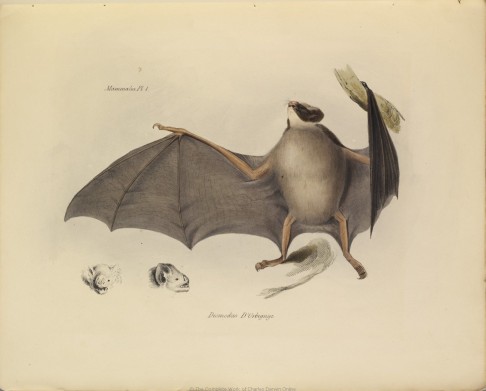
Desmodus D'Orbignyi.
[page break]
[page break]
[page break]
[Mammalia. Pl. 2.]
Mammalia. Pl. 2.

Phyllostoma Grayi.
[page break]
[page break]
[page break]
[Mammalia. Pl. 3.]
Mammalia. Pl. 3.

Vespertilio Chiloensis.
[page break]
[page break]
[page break]
[Mammalia. Pl 4.]
Mammalia. Pl 4.
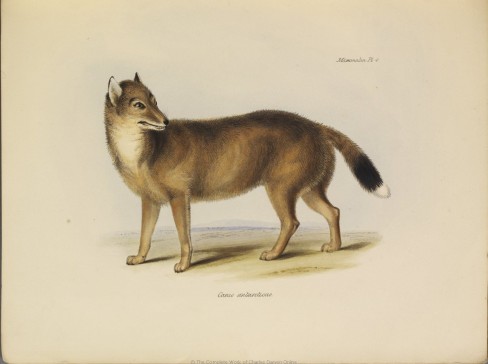
Canis antarcticus.
[page break]
[page break]
[page break]
[Mammalia. Pl 5.]
Mammalia. Pl 5.

Canis Magellanicus.
[page break]
[page break]
[page break]
[Mammalia. Pl. 6.]
Mammalia. Pl. 6.
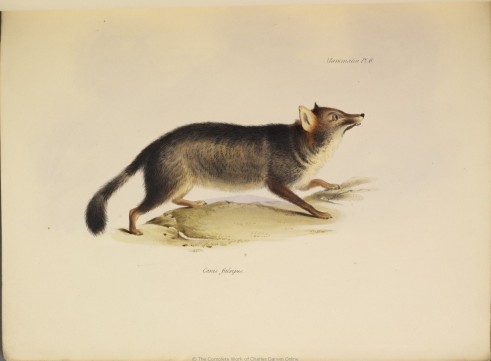
Canis fulvipes.
[page break]
[page break]
[page break]
[Mammalia Pl 7.]
Mammalia Pl 7.
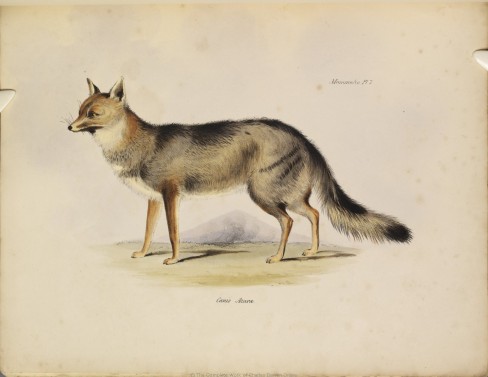
Canis Azaræ.
[page break]
[page break]
[page break]
[Mammalia. Pl. 8.]
Mammalia. Pl. 8.
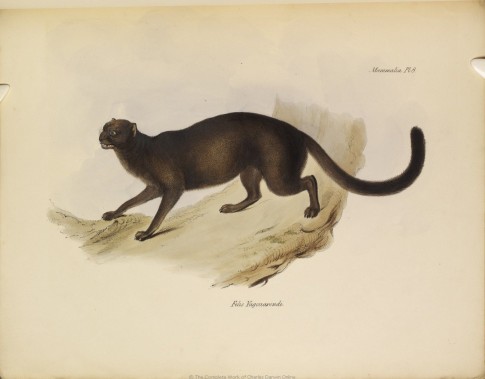
Felis Yagouarondi.
[page break]
[page break]
[page break]
[Mammalia Pl. 9]
Mammalia Pl. 9
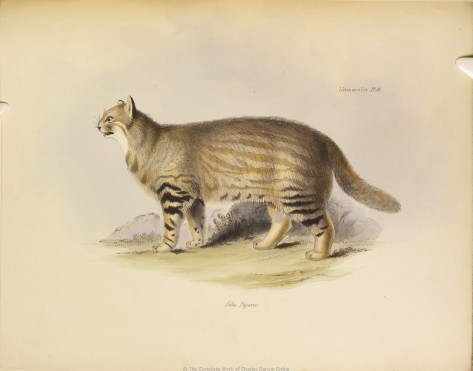
Felis Pajeros.
[page break]
[page break]
[Mammalia. Pl. 10]
Mammalia. Pl. 10
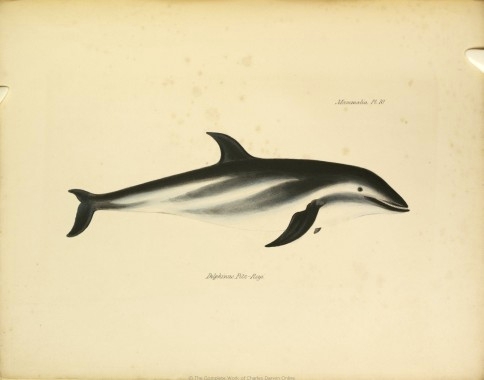
Delphinus Fitz-Royi.
[page break]
[Prospectus page 1]
THE
ZOOLOGY
OF
THE VOYAGE OF H.M.S. BEAGLE,
UNDER THE COMMAND OF CAPTAIN FITZROY, R.N.
DURING THE YEARS 1832 TO 1836.
————
PUBLISHED WITH THE APPROVAL OF
THE LORDS COMMISSIONERS OF HER MAJESTY'S TREASURY.
————
Edited and Superintended by
CHARLES DARWIN, ESQ., M.A., F.G.S.
NATURALIST TO THE EXPEDITION.
IN order to secure to science the full advantage of the discoveries in Natural History, during the Voyage of the Beagle, the Lords Commissioners of Her Majesty's Treasury have been pleased to make a liberal grant of money towards defrayiug part of the expenses of this publication. This work, in consequence, has been undertaken on a scale worthy of the high patronage it has thus received, and will be offered to the public at a much lower price than otherwise would have been possible.
Figures will be given of many species of animals hitherto unknown or but imperfectly described, together with an account of their habits, ranges, and places of habitation.
The collections were chiefly made in the provinces bordering on the Rio Plata, in Patagonia, the Falkland Islands, Tierra del Fuego, Chile, and the Galapagos Archipelago in the Pacific.
The following gentlemen, with a disinterested zeal for science, have undertaken different departments of the work; in those branches with which they are respectively best acquainted. Mr. OWEN will describe the Fossil Mammalia; Mr. WATERHOUSE the Recent Mammalia; Mr. GOULD the Birds; Mr. BELL the Reptiles; and the Rev. L. JENYNS the Fish.
A description of some of the invertebrate animals procured during the voyage will also be given. At the conclusion of the work Mr. DARWIN will incorporate the materials which have been collected, in a general sketch of the Zoology of the southern part of South America.
CONDITIONS OF PUBLICATION.
It is impossible, in the present stage of the undertaking, to define precisely its limits, or the exact order in which the several subjects will be published; but it is estimated that the work will extend to Twenty Numbers, one of which will be published on the first day of every alternate month; and the whole, when completed, will comprise about six hundred pages of letter-press, and from two hundred to two hundred and fifty Engravings, in Royal 4to.
The price of each Number may vary according to the quantity of Plates and letter-press it may contain, depending upon the subject of which it particularly treats; but it is estimated that the average price will not exceed Ten Shillings.
————————————
THE FIRST NUMBER IS NOW PUBLISHED, PRICE 8s.
CONTAINING
FOSSIL MAMMALIA,
BY RICHARD OWEN, ESQ., F.R.S.
HUNTERIAN PROFESSOR IN THE ROYAL COLLEGE OF SURGEONS :
WITH A NOTICE OF THEIR GEOLOGICAL POSITION,
BY CHARLES DARWIN, ESQ., M.A., F.G.S., ETC.
Just completed, in demy 12mo. price 6s.
THE PRISONERS OF ABD-EL-KADER;
OR,
FIVE MONTHS' CAPTIVITY AMONG THE ARABS,
IN THE AUTUMN OF 1836.
BY MONS. A. DE FRANCE.
TRANSLATED BY R.F. PORTER.
In the press, demy 8vo. with Plates.
A PERSONAL NARRATIVE OF
THE SIEGES OF BILBOA,
IN THE YEARS 1835 AND 1836;
and of the other principal events which
occurred in
that City
from 1832 to 1837.
Preceded by an Introduction describing the state of Parties in Spain prior to the Civil War, and giving some Account of the Basque Provinces, their privileges, &c.
BY JOHN FRANCIS BACON, ESQ.
Stewart and Murray, Old Bailey.
[Prospectus page 2]
PREPARING FOR PUBLICATION BY
SMITH, ELDER AND CO., CORNHILL.
————————————
In 2 Volumes, Demy 8vo.
THE JOURNAL OF AN EXPEDITION
INTO THE
INTERIOR OF SOUTHERN AFRICA,
IN THE YEARS 1834, 1835, AND 1836,
FITTED OUT BY
"THE CAPE OF GOOD HOPE ASSOCIATION FOR EXPLORING CENTRAL AFRICA. "
Comprising an Authentic Narrative of the Travels and Discoveries of the Expedition; an Account of the Manners and Customs of the Native Tribes; and of the Natural Productions, Aspect, and Physical Capabilities of the Country.
Illustrated by a Map and Numerous Plates of African Scenery, and of the Dresses, Weapons, Dances, &c. of the Natives.
BY ANDREW SMITH, M.D.
SURGEON TO THE FORCES, AND DIRECTOR OF THE EXPEDITION.
————————————
BY THE SAME AUTHOR,
TO BE PUBLISHED UNDER THE AUTHORITY OF
THE LORDS COMMISSIONERS OF HER MAJESTY'S TREASURY.
ILLUSTRATIONS OF
THE ZOOLOGY OF SOUTH AFRICA :
Comprising figures of all the new species
of
Quadrupeds, Birds,
Reptiles, and Fishes, obtained during the recent
expedition, with Letter Press descriptions, and a Summary of African
Zoology.
The whole of the Plates will be engraved in
the
highest style of Art,
from the Original Drawings taken expressly for
this work, and beautifully coloured after Nature.
To be issued in Parts, Royal 4to. size; price 10s. each, the first Part, it is expected, will be ready for publication in March next.
THE
ORIENTAL PORTFOLIO;
A
SERIES OF ILLUSTRATIONS
OF THE
SCENERY, ANTIQUITIES, ARCHITECTURE, MANNERS, COSTUME, ETC.
OF
THE EAST.
FROM ORIGINAL SKETCHES IN THE COLLECTIONS OF
LORD WILLIAM BENTINCK. / LADY WILMOT
HORTON.
CAPTAIN R. M. GRINDLAY. /
LIEUT. THOMAS BACON.
JAMES BAILLIE FRASER, ESQ.
AND OTHER TRAVELLERS.
————————————
THE object of this undertaking is to supply what has long been felt to be a desideratum; namely, graphic Illustrations of the Scenery, Antiquities, Architecture, Manners, Costumes, &c., of the East, which, as the theatre of so many brilliant military achievements, and such extensive commercial enterprize, is daily increasing in interest with the British Public.
The Drawings for the Work will be made by the first Artists in the kingdom, from Sketches taken on the spot, and the Plates will be executed in the novel and very beautiful style of Tinted Lithography, which is peculiarly adapted to the character of the Scenery, and the best calculated to afford a faithful representation of the original drawing.
~~~~~~~~~~~~~~~~
The Work will be published in Imperial Folio, the Engravings being an uniform size of 15 by 10 inches.
EACH NUMBER WILL CONTAIN FIVE PLATES,
WITH DESCRIPTIVE LETTER PRESS;
PRICE ONE GUINEA, IN A NEAT PORTFOLIO.
~~~~~~~~~~~~~~~~
It is intended to Publish the First Number on the 1st of March, 1838, and to continue the Work Quarterly; but owing to the very elaborate finish of the Drawings, the Proprietors cannot pledge themselves to its regular appearance.
[page break]
[page break]
[inside back cover]
[back cover]
[Continued in Mammalia Part 2 No. 2 ]